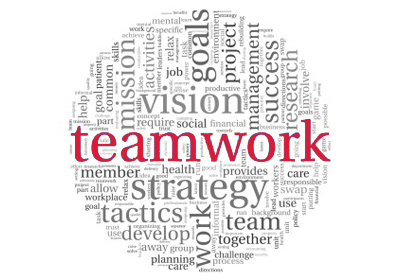Our perennial favourite blogger, Neil Crofts, has come up trumps again with this very insightful guest post on what a team really is:
There is a lot of talk of team work and team building in businesses, but the reality of teams and teamwork existing in business is patchy. There are, of course, some excellent teams, but a lot of groups who call themselves teams are not teams at all. Perhaps it would be be helpful to use more descriptive names than asserting that every group should also be a team?
Cycle racing provides a useful illustration of the types of groupings that we all experience in work and other situations. Cycling is a team sport. In cycling the teams ride supporting each other in pursuit of a common goal.
In a bike race, there are often a number of different goals to go for and typically the shared goal will be for the strongest rider in the team, in that discipline, to be supported in that aim. This will mean team mates riding in front to shelter their designated leader from the wind, helping them stay in a good position in the peleton for safety or pacing them back there if they are delayed for any reason. It will also mean collecting drinks and food from the team car, carrying them through the peleton to the other riders.
It is often thought that all of this work is on behalf of the leader, and perhaps in the old days it was, but sports people are much more aware of the importance of team today and three things are clear. Firstly, there is a huge responsibility on the leader to deliver. If for any reason they are unable to deliver, they must be honest with their team mates and not waste the teams efforts. Secondly, the leader must acknowledge and appreciate the efforts of the team on every occasion. And thirdly, the objective is not the glory of the leader, but the achievement of the agreed team objective.
The essence of team therefore is individual sacrifice, support and responsibility in pursuit of the common goal. The leader shares the majority of the responsibility for failure and must be humble in the face of success. And when circumstances demand it, the leader must be prepared to muck in or support other team members.
Another dynamic that occurs in cycling is when members of different teams are riding together, perhaps in a “breakaway” group ahead of the main peleton. This is definitely not a team. There will certainly be collaboration and there will also be sacrifice, but there are also individual objectives, as well as the common goal. Under the right circumstances, riders will wait for each other and shelter each other from the wind, they will not collect drinks or food and ultimately they will try to beat each other.
This is a coalition not a team. When their aims align they support each other, but there is always a priority agenda which they will jump to when the moment comes. In organisations, very often we are in more than one grouping, some of these groups are teams and some are coalitions, understanding the difference is important.
In both teams and coalitions we need clarity and alignment, which means communication is critical. In both cases, we need to understand exactly where to expect each other to make sacrifices or take responsibility. The difference is that in a team it entirely for the same objective, whereas in a coalition there will be a common goal AND separate ones as well, which will, at some point, take priority.
Harmony is often an overrated aspect of teams (or coalitions). Harmony can be helpful, but if it becomes an end in itself, robust debate and clear communication will be sacrificed. Equally excessive focus on accomplishing goals can lead to burnout or alienation of the team.
The most important element in both coalitions and teams and the collective responsibility of the participants is clear and honest communication and that is why calling a coalition a team is such a problem, because it starts things off with a fundamental dishonesty which can be hard to recover from.
[callout title=”What aspects are vital to your team?” button=”Here’s our take” link=”/services/team-development/” buttoncolor=”white, yellow, orange, red, blue, green, gray, black, alternative-1, alternative-2, alternative-3″ target=”_blank or _self”]Discover our Team Development programmes[/callout]
